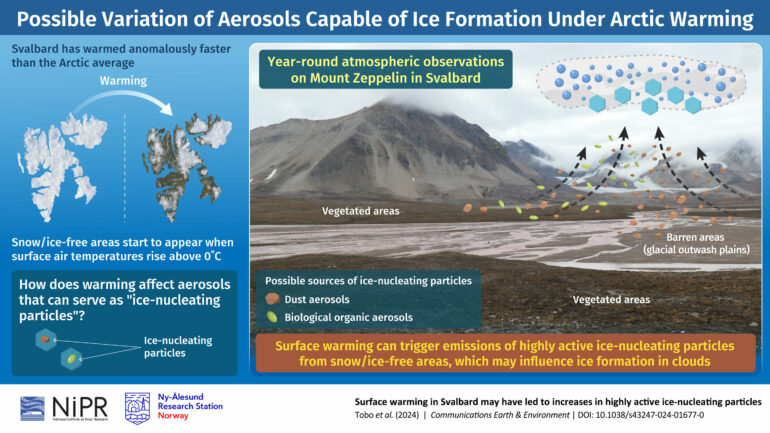The Arctic frequently experiences temperatures that support the formation of mixed-phase clouds that contain supercooled liquid droplets and ice crystals. The composition of such clouds plays a crucial role in the region’s energy balance and climate system. Clouds with more liquid last longer and reflect more sunlight than those with more ice crystals.
With Arctic warming, meteorologists have been interested in determining the effect of rising temperatures on cloud composition and its broader effect on the region. Climate models generally predict that as the Arctic warms, clouds in the region will contain more liquid water and less ice, since warmer temperatures typically suppress the formation of ice crystals.
However, cloud formation is also influenced by the presence of aerosols which act as seeds, both for the condensation of liquid droplets and the formation of ice crystals.
In a study published in Communications Earth & Environment, on 18 September 2024, researchers led by Associate Professor Yutaka Tobo from the National Institute of Polar Research, Japan, investigated the relationship between rising surface air temperatures and aerosols known as ice-nucleating particles (INPs), which are known to promote ice crystal formation in clouds.
They found that surface warming in the Arctic leads to an increase in snow and ice-free areas, which release higher amounts of active INPs. These INPs can induce ice formation in clouds, reducing the liquid water content in mixed-phase clouds and potentially accelerating further warming.
“We found that the INPs tended to increase exponentially with rising surface air temperatures when the temperatures rose above 0°C and snow/ice-free barren areas and vegetated areas appeared in Svalbard, a region experiencing warming five to seven times faster than the global average,” says Associate Professor Tobo.
The observations are based on year-round measurements of INPs taken during the Multidisciplinary drifting Observatory for the Study of Arctic Climate (MOSAiC) project period from September 2019 to early-October 2020 at the Zeppelin Observatory in Svalbard. To identify the number of INPs, the researchers collected aerosol samples and used an established droplet-freezing method, where the samples were exposed to cold conditions to see if they could form ice.
They observed that the number of INPs increased during the warmer months (mid-April to September), when surface air temperatures were above 0°C. Using scanning electron microscopy with energy-dispersive X-ray analysis, they found that the INPs observed in the warmer months were mainly mineral dust and carbonaceous particles, resembling microorganisms or plant debris.
So, where did these aerosols come from? The Normalized Difference Vegetation Index (NDVI) data, which indicates vegetation density, revealed that in the summer, about 35% of Svalbard had positive NDVI values between 0 and 0.5, indicating snow-free barren areas like glacial outwash plains and vegetated areas with grasses, mosses, and lichens. The findings suggest that the INPs are the dust and biological organic aerosols, such as microorganisms or plant debris, released from these regions.
The findings are concerning because winter warming trends are even more severe than in summer, with temperatures increasing by more than 2°C per decade in Svalbard. As snow and ice-free areas become more common in the Arctic winter in the coming decades, INP emissions will likely increase, changing the composition of mixed-phase clouds.
“Our results suggest the possibility that the supply of highly active INPs from high-latitude terrestrial sources will increase in response to the projected surface warming, and thus, this effect needs to be considered in climate models to improve our understanding of the phase transition scenario of Arctic mixed-phase clouds,” concludes Associate Professor Tobo.
More information:
Tobo, Y., et al. Surface warming in Svalbard may have led to increases in highly active ice nucleating particles, Communications Earth & Environment (2024). DOI: 10.1038/s43247-024-01677-0. www.nature.com/articles/s43247-024-01677-0
Provided by
Research Organization of Information and Systems
Citation:
Arctic warming may fuel ice formation in clouds, observations suggest (2024, September 19)



